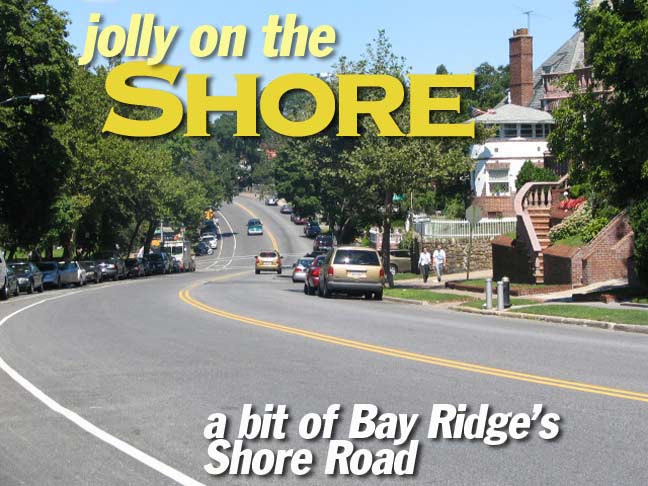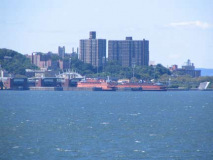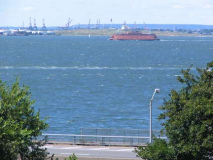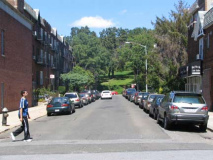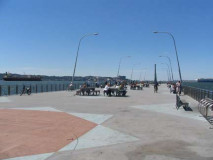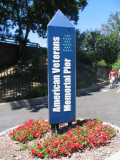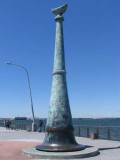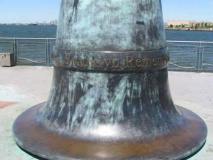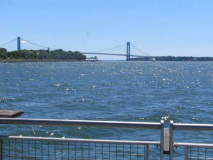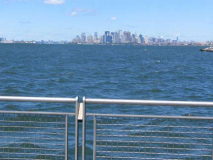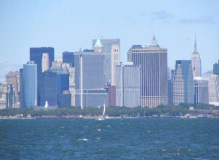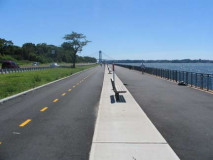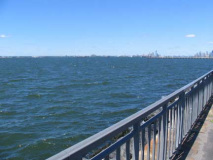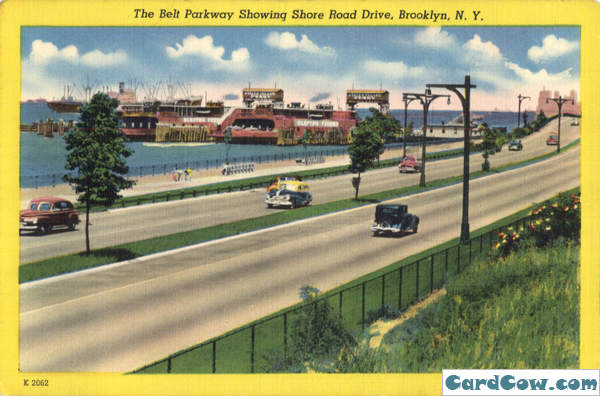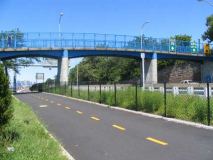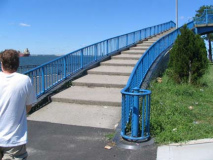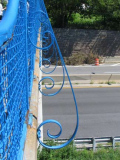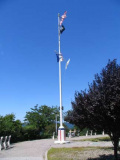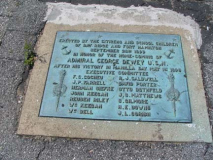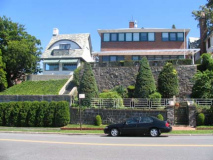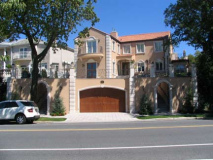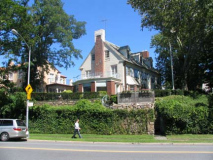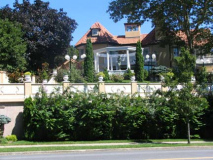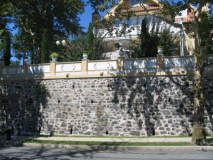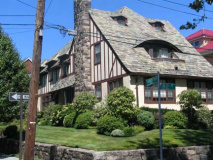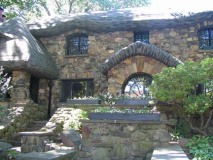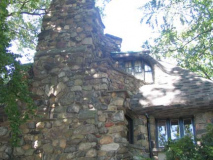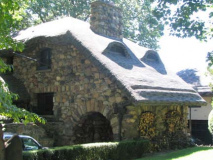“I am Bay Ridge.”
That might sound funny coming from your webmaster, who hasn’t lived there since 1993, and whose only real-life connection to the old neighborhood is my dentist, whose office is on 4th Avenue and 75th Street (for non Bay Ridgers, Bay Ridge Parkway). I frequently go back, however, and in August 2007 chose one of the more gorgeous days of the year to stroll along the pedestrian walkway along the water from Owls Head Park to about 80th Street, taking in the waterfront views, as well as the remaining Shore Road mansions.
Left Behind
Where’s Walsho? Spot your webmaster in this composite 1971 class photo. Suzanne Stonbely, top row second from left, is a prominent clinical social worker in South Beach, Miami, Florida, while Joe Herbert, bottom row right, is a detective who helped catch a serial killer in the 1990s.
I should not remember Bay Ridge as fondly as I do. In St. Anselm’s grade school, where much of my pre-teen years were spent, I was despised by many classmates as well as many of the teachers; I still hold dear the date of June 17, 1971, the day I escaped the place; and I have never set foot in the building again. The year I graduated, I asked my 8th-grade teacher, a 75-year old crone of a nun for whom the school’s basement rec room is unaccountably named, for something or other one day and received this response: “I wouldn’t give you the time of day.”
Before this begins to sound too much like the Dr. Evil at the psychotherapist scene from Austin Powers…
By the 1980s I endured Bay Ridge’s horrific commute time to jobs in Manhattan; for much of the 1990s, there was no express subway service, nor was there any Manhattan Bridge service, meaning it took about an hour and 20 minutes to get to work by subway. (Sometimes I just took the express bus, which was $4 each way then.) I did better when I worked nights in the 1980s and caught the train home at 3-4 AM!
Even before conceiving of FNY, though, I recognized Bay Ridge as a NYC treasure; its water views, unusual architecture, unexpected hills, and bits and pieces of American history such as the Church of the Generals (at which Robert E. Lee and Stonewall Jackson were vestrymen), Fort Hamilton, the Verrazano-Narrows Bridge, and the colonial-era Barkaloo Cemetery on Narrows Avenue all contributed to a feeling that I lived somewhere special and that opinion has not dimmed despite my move to Queens to be closer to a job in Long Island.
If only Zeke’s Roast Beef had not succumbed to demographics and become a Chinese restaurant. [It since reopened on 3rd Avenue in 2010!]
Owls Eye View
Owl’s Head Park and the Narrows view. The Narrows is the strait that separates Upper and Lower New York Bays, as well as Brooklyn and Staten Island. It’s not that narrow, however, and when the Verrazano-Narrows Bridge was built from 1959-1964 it was the longest suspension bridge in the world at the time; it has been surpassed several times since then, of course.
Owls Head Park is Bay Ridge’s largest public park, stretching between the Belt Parkway, Colonial Road and 68th Street, and its high hill provides a prime viewing spot during Brooklyn’s occasional tall ship parades. The park was created from the estate of Eliphalet Bliss (1836-1903). In 1867 he founded the machine shops that became the E. W. Bliss Company and the United States Projectile Company, concerns which at his death employed 1,300 men. Bliss’s interests developed along two lines: the manufacture of tools, presses, and dies for use in sheet metal work, and the manufacture of shells and projectiles. His estate, Owls Head, possibly named because the promontory on which it was located resembled an owl’s head (or because there may have been stone owls’ heads on the gateposts), featured an observatory known as the Bayard Tower. Bliss had purchased the estate from US State Senator, US Representative, Mayor of Brooklyn, and Brooklyn Eagle founder Henry Murphy (1810-1882). Bliss willed the estate to NYC provided it be used for parkland. The park, still known by old-timers as Bliss Park, has been in use by local residents since the 1920s; Robert Moses redesigned it in the 1930s. The mansion and tower were razed in 1940. Senator Street is named for Murphy, while one-block Bliss Terrace was named for the industrialist.
The Staten Island Ferry’s route between South Ferry, Manhattan, and St. George, Staten Island, runs past Bay Ridge. Shown is one of Brooklyn’s more unusually-named Streets, Owl’s Head Court, with its eponymous park in the background.
American Veterans Memorial Pier, west end of Bay Ridge Avenue (69th Street). For several decades, ferry service to St. George, Staten Island ran from this pier, but service ended the day after the Verrazano Bridge opened in November 1964.
Note the davit-type lampposts on the pier: they are reminiscent of the curved posts that used to light the roadways at John F. Kennedy Airport. Another view here.
For several years the old pier, which was made of wood, deteriorated from the effects of wind, salt water and sea life. Finally it was reconstructed from poured concrete in the 1980s, and rebuilt once again as the AVMP in the early 2000s.
Bay Ridge’s 9/11/01 memorial is located on the pier. Soaring 25 feet in the air, the “Beacon” memorial is shaped like a speaking trumpet. The device was once used by the volunteer fire brigades of New York City to transmit warnings to the crowd, and orders to firefighters, while also alerting neighbors of a crisis in progress. Made of bronze, the memorial features a beacon of light shining from the top is illuminated from 9:00 pm to 11:00 pm daily. NYC.gov
Views northeast, to midtown Manhattan, and southwest, to the Verrazano Bridge, are readily available from the pier, which is popular with fishermen despite the fact that a sewage treatment plant is located just to its north. Watch for the 3-eyed fish!
The King of All Buildings looks rather short but that is merely due to the angle of the photo.
Brooklyn, to its credit, has many points of public access to its coast, such as the beaches along its south shore, the Brooklyn Heights Promenade, and the Bay Ridge pedestrian and bike path (which to my knowledge has no formal name, unlike Coney Island’s Riegelmann Boardwalk). It runs from the ferry pier southeast to Bay Parkway at Ceasar’s [sic] Bay Bazaar. Winter storms always take their toll on this path and some of it always has to be rebuilt in the spring.
In the photo right, the clump of buildings in the center is the revitalized Jersey City, while Manhattan is on the right.
Brooklyn Ribbon
The Belt Parkway, a.k.a. Shore Parkway, a.k.a. the Circumferential Parkway, a.k.a. Leif Ericson Drive, was first proposed by NYC traffic czar Robert Moses in 1930 and, since in those days what Moses wanted Moses got, the parkway began construction in 1934 and was completed in 1940. The photos above and below show the parkway in roughly the same spot from different angles. The “woodie” lampposts shown above were a feature of all Moses’ parkways on Long Island and the city until the 1970s, when they began to be phased out. Today, just two remain: on a Flatbush Avenue exit ramp and a westbound entrance ramp where the Belt meets the Laurelton Parkway in eastern Queens.
Also in the above rendering we see the 69th Street (now the American Veterans Memorial Pier), at a time when it was the busy Brooklyn terminal of the Bay Ridge-Staten Island ferry. A much smaller ferry now operates to Manhattan from the west end of 58th Street.
The construction of the Belt Parkway worked out pretty well for Bay Ridge, recreationally-speaking. The borough gained a spectacular waterside walkway in an era when NYC’s waterfront was mostly given over to industry.
One of Moses’ legacies was the construction of three very handsome pedestrian bridges crossing the Belt Parkway in Bay Ridge and Bensonhurst: one at about 80th Street, pictured here, another at about Ridge Boulevard, and a third at 17th Avenue.
These bridges, that were built in the late 1930s, were probably among the last significant structures in NYC that employed decorative scrollwork. In the 1930s more streamlined Art Moderne styles took over, and decorative elements like this were shelved in favor of stark, unadorned utilitarian styles; pedestrian walkways built today are strictly no-frills, boring stuff. These 3 bridges really should be landmarked.
Crossing the parkway over the bridge, we find Old Glory Lookout, a tall flagpole and a tablet “erected by the citizens and school children of Bay Ridge and Fort Hamilton September 28th, 1899 in honor of the homecoming of Admiral George Dewey, USN, after his victory in Manilla [sic] Bay, May 1st, 1898.”
“Homecoming” refers to Dewey’s return to the USA after a year in the Philippines:
On April 24, 1898, word was recieved that The US and Spain were at war. The Asiatic Squadron was ordered by the British to leave Hong Kong. It first moved 30 miles north to Mirs Bayon the Chinese coast and on the 27th departed for the Philippines. Dewey and his fleet reached Manila Bay on the evening of April 30, and defeated the Spanish fleet there the following day.
Following the Battle of Manila Bay/Cavite, Dewey fever swept across the United States. He was promoted to Rear-Admiral in mid-May. With the Spanish fleet destroyed, Dewey’s Asiatic Squadron blockaded Manila and awaited the arrival of the American army, the first units of which arrived at the end of June. Manila surrendered on August 15, 1898, two days after the United States signed an Armistice with Spain. During the remainder of Dewey’s stay in the Philippines, the Navy played a relatively minor part in supressing the Filipino uprising against the American occupation, which came to be known as the “Philippine American War.”
In March, 1899, by an act of Congress, Dewey was appointed Admiral of the Navy. On the late afternoon of May 20, 1899, the OLYMPIA steamed slowly past Corregidor Island and out of Manila Bay. It had been one year and twenty days since Dewey first arrived in the Philippines, during which time he never left the islands. On September 26, 1899, the OLYMPIA reached the coast of the United States. Dewey led a Victory parade in New York City on September 30, 1899. He also participated in celebrations in Washington, DC and Montpelier, Vermont. “Dewey Fever” was at its peak. Anything and everything possible was created bearing the image of Dewey and OLYMPIA, from soap to furniture to toys. spanamwar.com
Cliffs of Bay Ridge
High stone wall and magnificent Tudor, Harborview Terrace and 82nd Street
Gingerbread House
You cannot profile this area in Brooklyn without mentioning the Howard and Jessie Jones House, known popularly as the Gingerbread House, 8220 Narrows Avenue at 83rd Street. It was constructed by J. Sarsfield Kennedy for the titular owners from 1916-1917; Kennedy also designed Long Island country homes, as well as the Prospect Park Picnic House and the Fort Hamilton Park War Memorial elsewhere in Bay Ridge. Kennedy is also a member of the National Lacrosse Hall of Fame. It is alternately described as “Black Forest Art Nouveaux” or Arts & Crafts, an architectural/artistic genre championed by William Morris, Frank Lloyd Wright, and Oscar Wilde.
The AIA Guide to NYC calls it “a mansion disguised as a witch’s hideaway” with “bumpety stone and pseudothatchery.” There remains scant information available, unfortunately, about this beautiful building because the owners have steadfastly refused to answer any inquiries or, indeed, answer the door, as Brooklyn Paper columnist Matthew Lysiak discovered when he attempted it. Perhaps they were away at the time. Though information on what’s inside is sketchy, Lysiak reports:
A real-estate source familiar with the property told The Stoop this week that the house “has a bowling alley in the basement and a revolving garage door. All they have to do is push a button, and the entire garage floor shifts so they never have to back out.”
He estimated the value of the property at “well over $5 million,” though in reality, it’s probably priceless.
1/6/08

